Analysis of Quality Management in NHS Health and Social Care Services
VerifiedAdded on 2023/02/02
|11
|3148
|64
Report
AI Summary
This report assesses quality management within an NHS hospital, examining stakeholder perspectives, the impact of poor-quality services, and the role of external agencies in setting standards. It evaluates the effectiveness of existing systems, policies, and procedures in achieving quality, identifies factors influencing quality achievement, and proposes ways to improve healthcare quality from both internal and external viewpoints. The analysis covers quality standards, implementation approaches, and potential barriers, such as waiting times, training deficiencies, and resource limitations. Specific policies and systems, including NICE and CQC guidelines, are discussed, along with the importance of continuous improvement and total quality management (TQM) to enhance service delivery and patient satisfaction. Desklib provides access to this and other solved assignments for students.
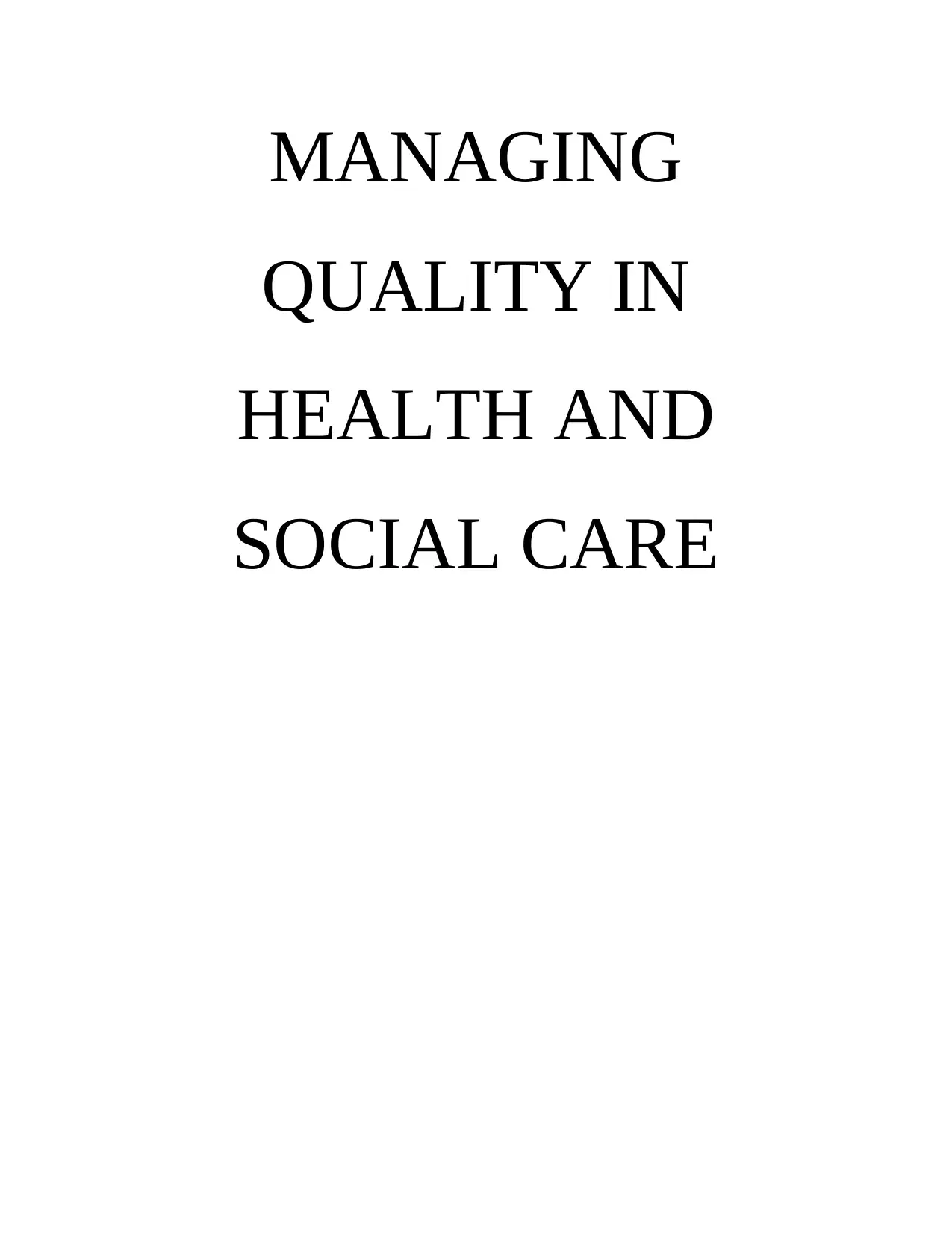
MANAGING
QUALITY IN
HEALTH AND
SOCIAL CARE
QUALITY IN
HEALTH AND
SOCIAL CARE
Paraphrase This Document
Need a fresh take? Get an instant paraphrase of this document with our AI Paraphraser
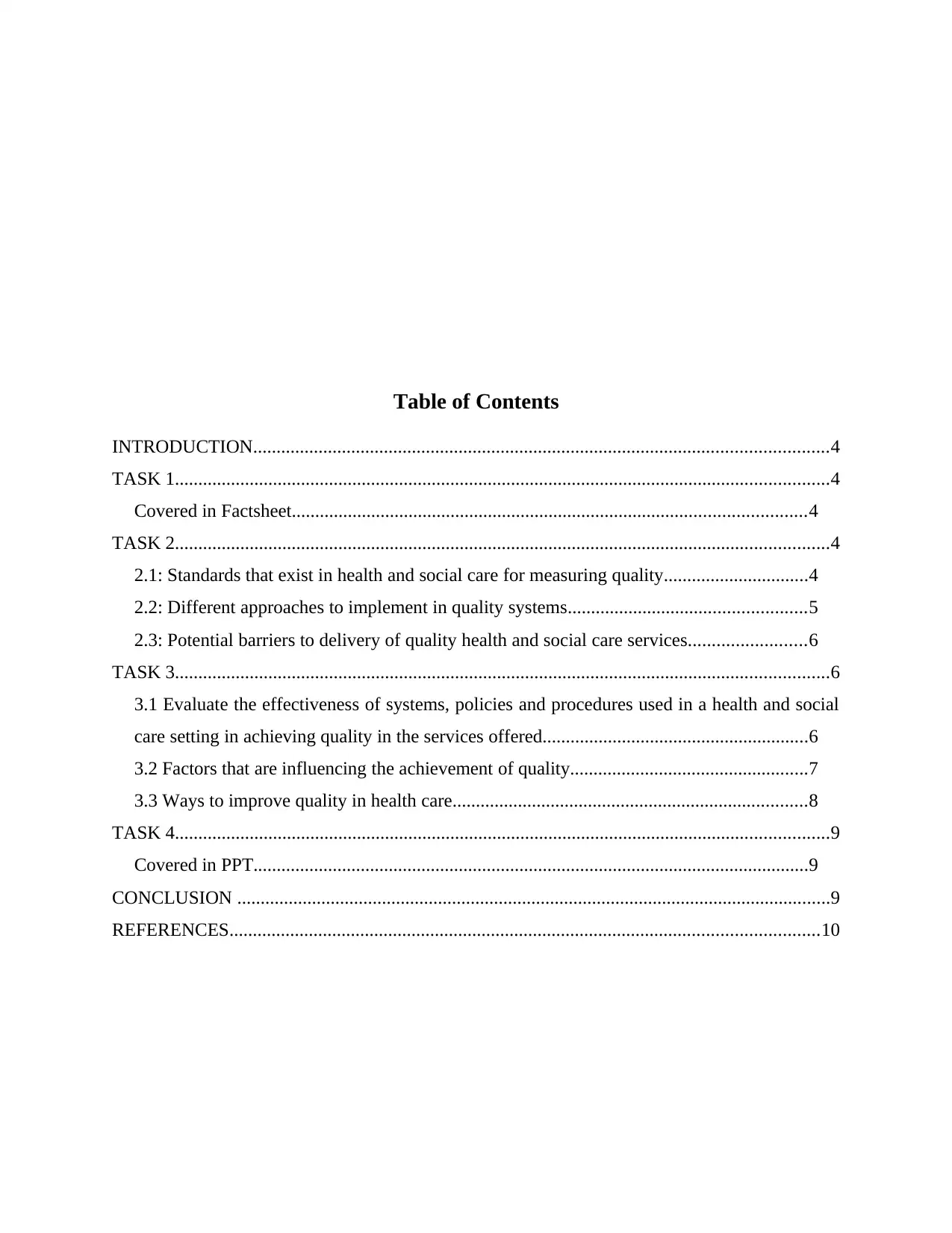
Table of Contents
INTRODUCTION...........................................................................................................................4
TASK 1............................................................................................................................................4
Covered in Factsheet..............................................................................................................4
TASK 2............................................................................................................................................4
2.1: Standards that exist in health and social care for measuring quality...............................4
2.2: Different approaches to implement in quality systems...................................................5
2.3: Potential barriers to delivery of quality health and social care services.........................6
TASK 3............................................................................................................................................6
3.1 Evaluate the effectiveness of systems, policies and procedures used in a health and social
care setting in achieving quality in the services offered.........................................................6
3.2 Factors that are influencing the achievement of quality...................................................7
3.3 Ways to improve quality in health care............................................................................8
TASK 4............................................................................................................................................9
Covered in PPT.......................................................................................................................9
CONCLUSION ...............................................................................................................................9
REFERENCES..............................................................................................................................10
INTRODUCTION...........................................................................................................................4
TASK 1............................................................................................................................................4
Covered in Factsheet..............................................................................................................4
TASK 2............................................................................................................................................4
2.1: Standards that exist in health and social care for measuring quality...............................4
2.2: Different approaches to implement in quality systems...................................................5
2.3: Potential barriers to delivery of quality health and social care services.........................6
TASK 3............................................................................................................................................6
3.1 Evaluate the effectiveness of systems, policies and procedures used in a health and social
care setting in achieving quality in the services offered.........................................................6
3.2 Factors that are influencing the achievement of quality...................................................7
3.3 Ways to improve quality in health care............................................................................8
TASK 4............................................................................................................................................9
Covered in PPT.......................................................................................................................9
CONCLUSION ...............................................................................................................................9
REFERENCES..............................................................................................................................10

⊘ This is a preview!⊘
Do you want full access?
Subscribe today to unlock all pages.

Trusted by 1+ million students worldwide
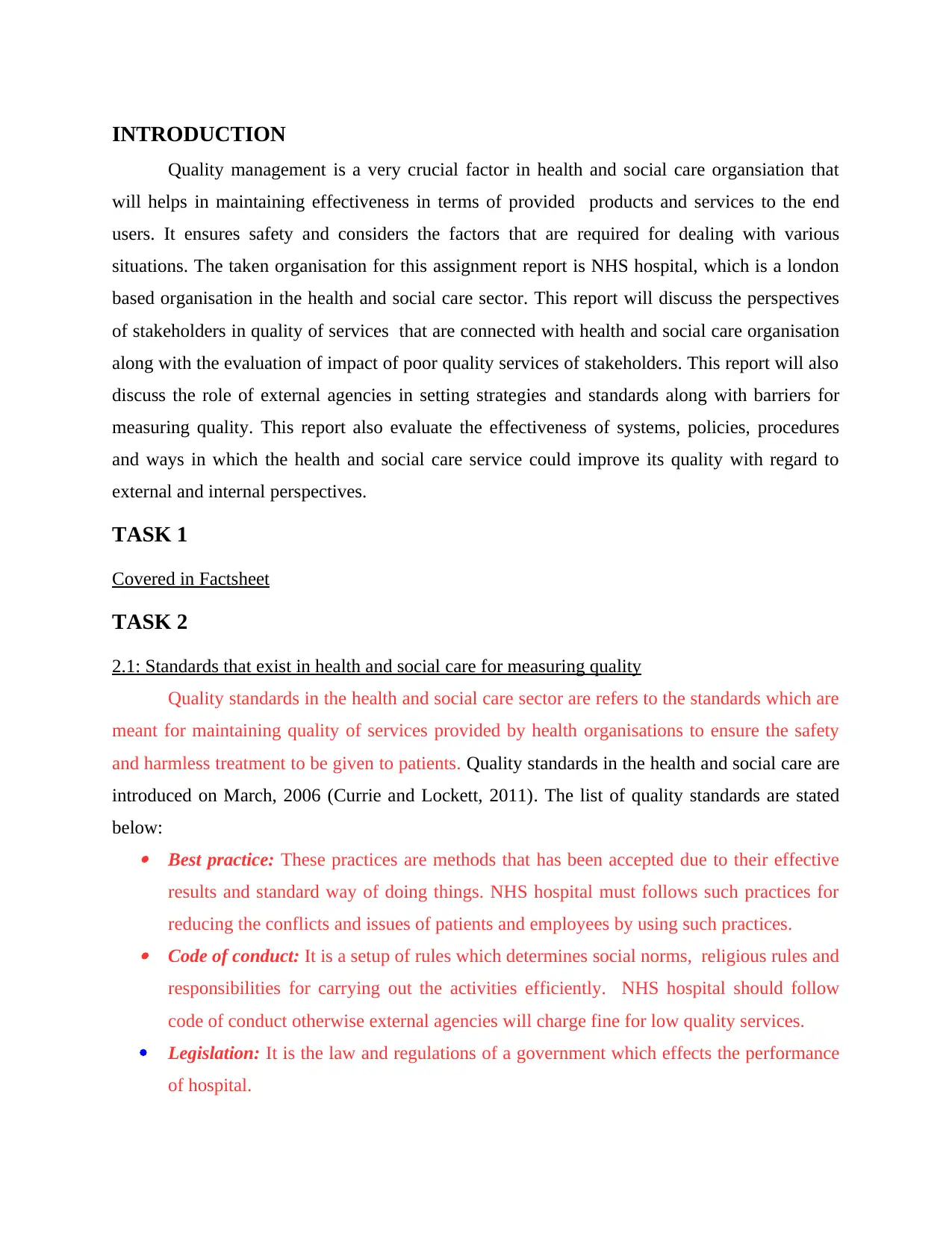
INTRODUCTION
Quality management is a very crucial factor in health and social care organsiation that
will helps in maintaining effectiveness in terms of provided products and services to the end
users. It ensures safety and considers the factors that are required for dealing with various
situations. The taken organisation for this assignment report is NHS hospital, which is a london
based organisation in the health and social care sector. This report will discuss the perspectives
of stakeholders in quality of services that are connected with health and social care organisation
along with the evaluation of impact of poor quality services of stakeholders. This report will also
discuss the role of external agencies in setting strategies and standards along with barriers for
measuring quality. This report also evaluate the effectiveness of systems, policies, procedures
and ways in which the health and social care service could improve its quality with regard to
external and internal perspectives.
TASK 1
Covered in Factsheet
TASK 2
2.1: Standards that exist in health and social care for measuring quality
Quality standards in the health and social care sector are refers to the standards which are
meant for maintaining quality of services provided by health organisations to ensure the safety
and harmless treatment to be given to patients. Quality standards in the health and social care are
introduced on March, 2006 (Currie and Lockett, 2011). The list of quality standards are stated
below: Best practice: These practices are methods that has been accepted due to their effective
results and standard way of doing things. NHS hospital must follows such practices for
reducing the conflicts and issues of patients and employees by using such practices. Code of conduct: It is a setup of rules which determines social norms, religious rules and
responsibilities for carrying out the activities efficiently. NHS hospital should follow
code of conduct otherwise external agencies will charge fine for low quality services.
Legislation: It is the law and regulations of a government which effects the performance
of hospital.
Quality management is a very crucial factor in health and social care organsiation that
will helps in maintaining effectiveness in terms of provided products and services to the end
users. It ensures safety and considers the factors that are required for dealing with various
situations. The taken organisation for this assignment report is NHS hospital, which is a london
based organisation in the health and social care sector. This report will discuss the perspectives
of stakeholders in quality of services that are connected with health and social care organisation
along with the evaluation of impact of poor quality services of stakeholders. This report will also
discuss the role of external agencies in setting strategies and standards along with barriers for
measuring quality. This report also evaluate the effectiveness of systems, policies, procedures
and ways in which the health and social care service could improve its quality with regard to
external and internal perspectives.
TASK 1
Covered in Factsheet
TASK 2
2.1: Standards that exist in health and social care for measuring quality
Quality standards in the health and social care sector are refers to the standards which are
meant for maintaining quality of services provided by health organisations to ensure the safety
and harmless treatment to be given to patients. Quality standards in the health and social care are
introduced on March, 2006 (Currie and Lockett, 2011). The list of quality standards are stated
below: Best practice: These practices are methods that has been accepted due to their effective
results and standard way of doing things. NHS hospital must follows such practices for
reducing the conflicts and issues of patients and employees by using such practices. Code of conduct: It is a setup of rules which determines social norms, religious rules and
responsibilities for carrying out the activities efficiently. NHS hospital should follow
code of conduct otherwise external agencies will charge fine for low quality services.
Legislation: It is the law and regulations of a government which effects the performance
of hospital.
Paraphrase This Document
Need a fresh take? Get an instant paraphrase of this document with our AI Paraphraser
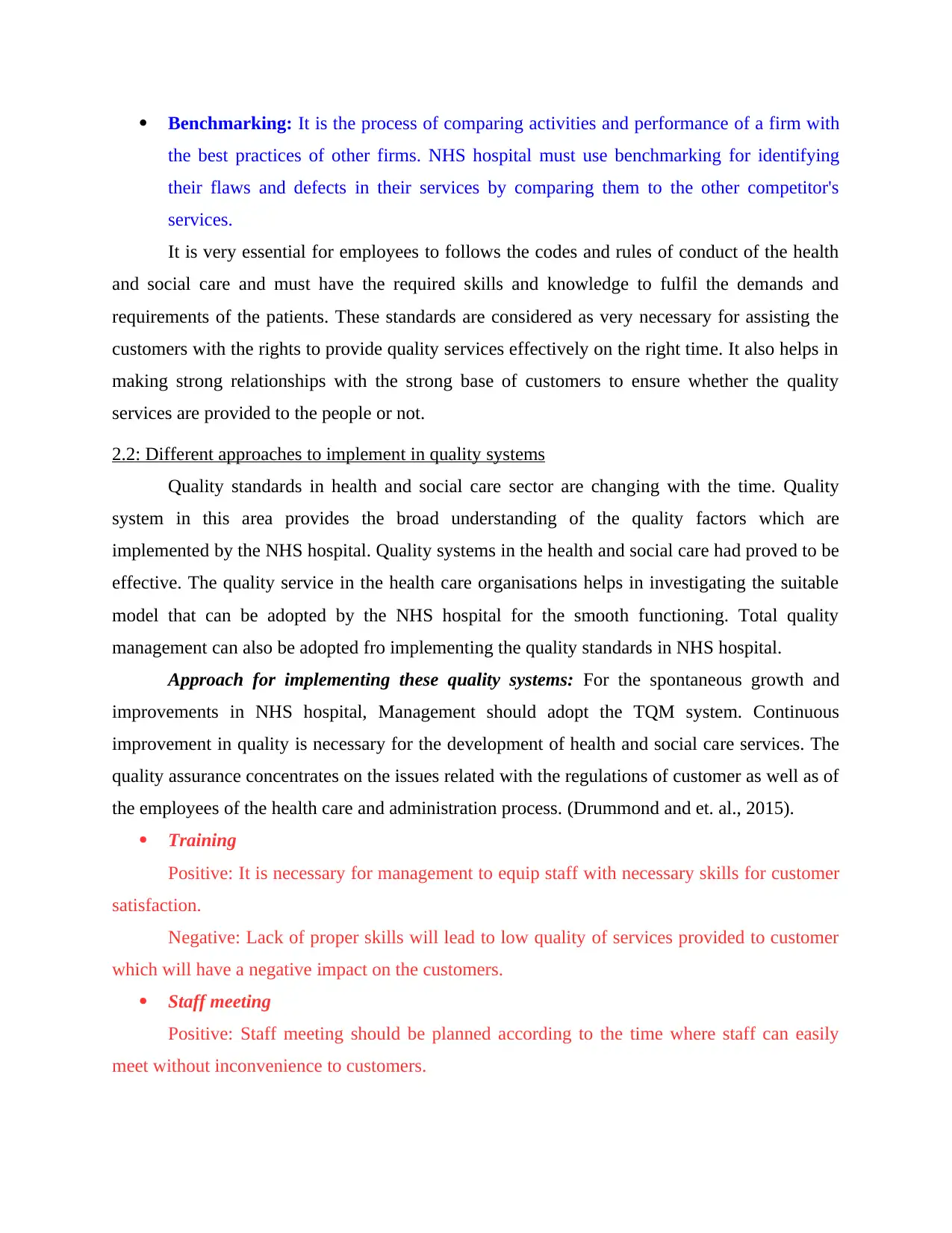
Benchmarking: It is the process of comparing activities and performance of a firm with
the best practices of other firms. NHS hospital must use benchmarking for identifying
their flaws and defects in their services by comparing them to the other competitor's
services.
It is very essential for employees to follows the codes and rules of conduct of the health
and social care and must have the required skills and knowledge to fulfil the demands and
requirements of the patients. These standards are considered as very necessary for assisting the
customers with the rights to provide quality services effectively on the right time. It also helps in
making strong relationships with the strong base of customers to ensure whether the quality
services are provided to the people or not.
2.2: Different approaches to implement in quality systems
Quality standards in health and social care sector are changing with the time. Quality
system in this area provides the broad understanding of the quality factors which are
implemented by the NHS hospital. Quality systems in the health and social care had proved to be
effective. The quality service in the health care organisations helps in investigating the suitable
model that can be adopted by the NHS hospital for the smooth functioning. Total quality
management can also be adopted fro implementing the quality standards in NHS hospital.
Approach for implementing these quality systems: For the spontaneous growth and
improvements in NHS hospital, Management should adopt the TQM system. Continuous
improvement in quality is necessary for the development of health and social care services. The
quality assurance concentrates on the issues related with the regulations of customer as well as of
the employees of the health care and administration process. (Drummond and et. al., 2015).
Training
Positive: It is necessary for management to equip staff with necessary skills for customer
satisfaction.
Negative: Lack of proper skills will lead to low quality of services provided to customer
which will have a negative impact on the customers.
Staff meeting
Positive: Staff meeting should be planned according to the time where staff can easily
meet without inconvenience to customers.
the best practices of other firms. NHS hospital must use benchmarking for identifying
their flaws and defects in their services by comparing them to the other competitor's
services.
It is very essential for employees to follows the codes and rules of conduct of the health
and social care and must have the required skills and knowledge to fulfil the demands and
requirements of the patients. These standards are considered as very necessary for assisting the
customers with the rights to provide quality services effectively on the right time. It also helps in
making strong relationships with the strong base of customers to ensure whether the quality
services are provided to the people or not.
2.2: Different approaches to implement in quality systems
Quality standards in health and social care sector are changing with the time. Quality
system in this area provides the broad understanding of the quality factors which are
implemented by the NHS hospital. Quality systems in the health and social care had proved to be
effective. The quality service in the health care organisations helps in investigating the suitable
model that can be adopted by the NHS hospital for the smooth functioning. Total quality
management can also be adopted fro implementing the quality standards in NHS hospital.
Approach for implementing these quality systems: For the spontaneous growth and
improvements in NHS hospital, Management should adopt the TQM system. Continuous
improvement in quality is necessary for the development of health and social care services. The
quality assurance concentrates on the issues related with the regulations of customer as well as of
the employees of the health care and administration process. (Drummond and et. al., 2015).
Training
Positive: It is necessary for management to equip staff with necessary skills for customer
satisfaction.
Negative: Lack of proper skills will lead to low quality of services provided to customer
which will have a negative impact on the customers.
Staff meeting
Positive: Staff meeting should be planned according to the time where staff can easily
meet without inconvenience to customers.
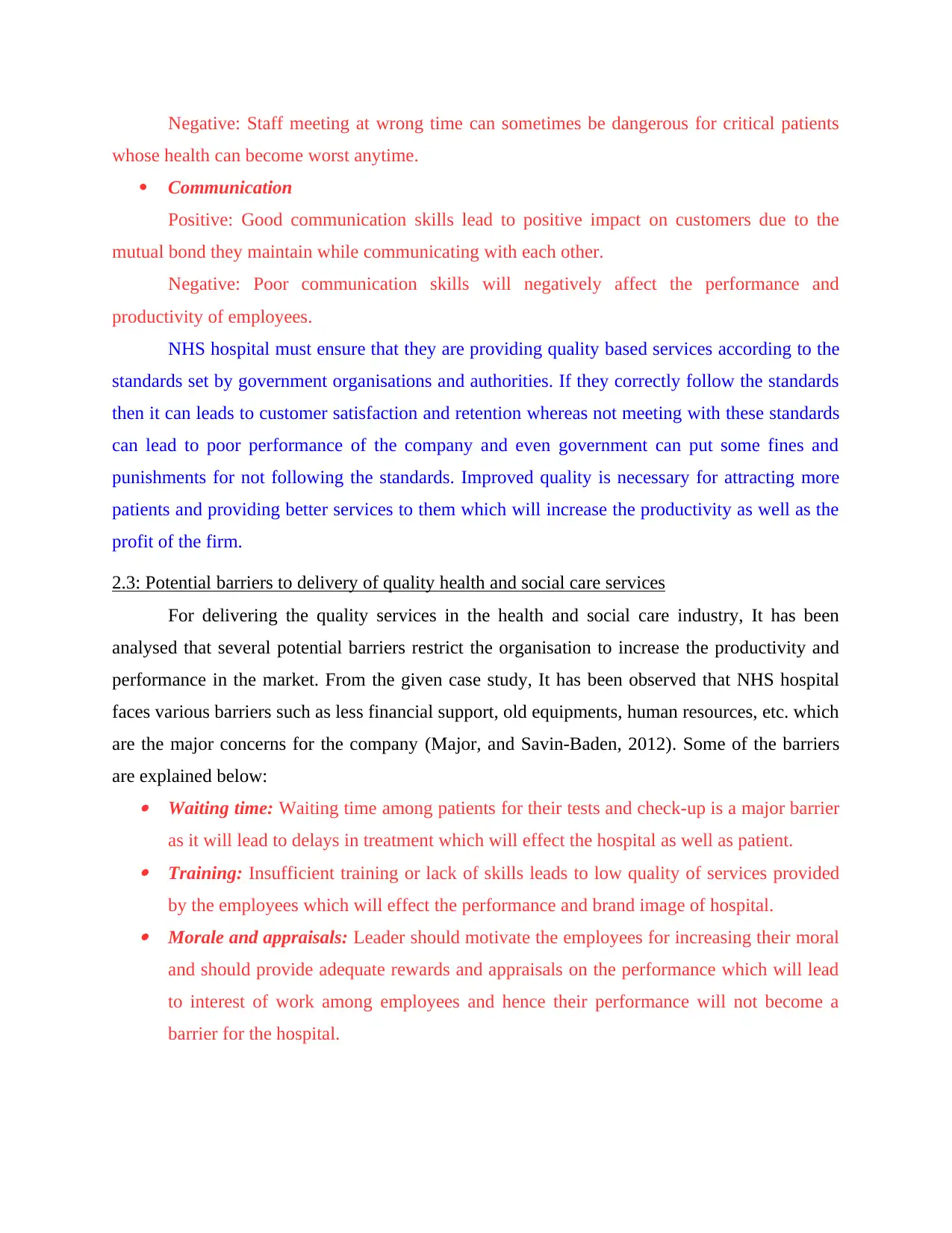
Negative: Staff meeting at wrong time can sometimes be dangerous for critical patients
whose health can become worst anytime.
Communication
Positive: Good communication skills lead to positive impact on customers due to the
mutual bond they maintain while communicating with each other.
Negative: Poor communication skills will negatively affect the performance and
productivity of employees.
NHS hospital must ensure that they are providing quality based services according to the
standards set by government organisations and authorities. If they correctly follow the standards
then it can leads to customer satisfaction and retention whereas not meeting with these standards
can lead to poor performance of the company and even government can put some fines and
punishments for not following the standards. Improved quality is necessary for attracting more
patients and providing better services to them which will increase the productivity as well as the
profit of the firm.
2.3: Potential barriers to delivery of quality health and social care services
For delivering the quality services in the health and social care industry, It has been
analysed that several potential barriers restrict the organisation to increase the productivity and
performance in the market. From the given case study, It has been observed that NHS hospital
faces various barriers such as less financial support, old equipments, human resources, etc. which
are the major concerns for the company (Major, and Savin-Baden, 2012). Some of the barriers
are explained below: Waiting time: Waiting time among patients for their tests and check-up is a major barrier
as it will lead to delays in treatment which will effect the hospital as well as patient. Training: Insufficient training or lack of skills leads to low quality of services provided
by the employees which will effect the performance and brand image of hospital. Morale and appraisals: Leader should motivate the employees for increasing their moral
and should provide adequate rewards and appraisals on the performance which will lead
to interest of work among employees and hence their performance will not become a
barrier for the hospital.
whose health can become worst anytime.
Communication
Positive: Good communication skills lead to positive impact on customers due to the
mutual bond they maintain while communicating with each other.
Negative: Poor communication skills will negatively affect the performance and
productivity of employees.
NHS hospital must ensure that they are providing quality based services according to the
standards set by government organisations and authorities. If they correctly follow the standards
then it can leads to customer satisfaction and retention whereas not meeting with these standards
can lead to poor performance of the company and even government can put some fines and
punishments for not following the standards. Improved quality is necessary for attracting more
patients and providing better services to them which will increase the productivity as well as the
profit of the firm.
2.3: Potential barriers to delivery of quality health and social care services
For delivering the quality services in the health and social care industry, It has been
analysed that several potential barriers restrict the organisation to increase the productivity and
performance in the market. From the given case study, It has been observed that NHS hospital
faces various barriers such as less financial support, old equipments, human resources, etc. which
are the major concerns for the company (Major, and Savin-Baden, 2012). Some of the barriers
are explained below: Waiting time: Waiting time among patients for their tests and check-up is a major barrier
as it will lead to delays in treatment which will effect the hospital as well as patient. Training: Insufficient training or lack of skills leads to low quality of services provided
by the employees which will effect the performance and brand image of hospital. Morale and appraisals: Leader should motivate the employees for increasing their moral
and should provide adequate rewards and appraisals on the performance which will lead
to interest of work among employees and hence their performance will not become a
barrier for the hospital.
⊘ This is a preview!⊘
Do you want full access?
Subscribe today to unlock all pages.

Trusted by 1+ million students worldwide
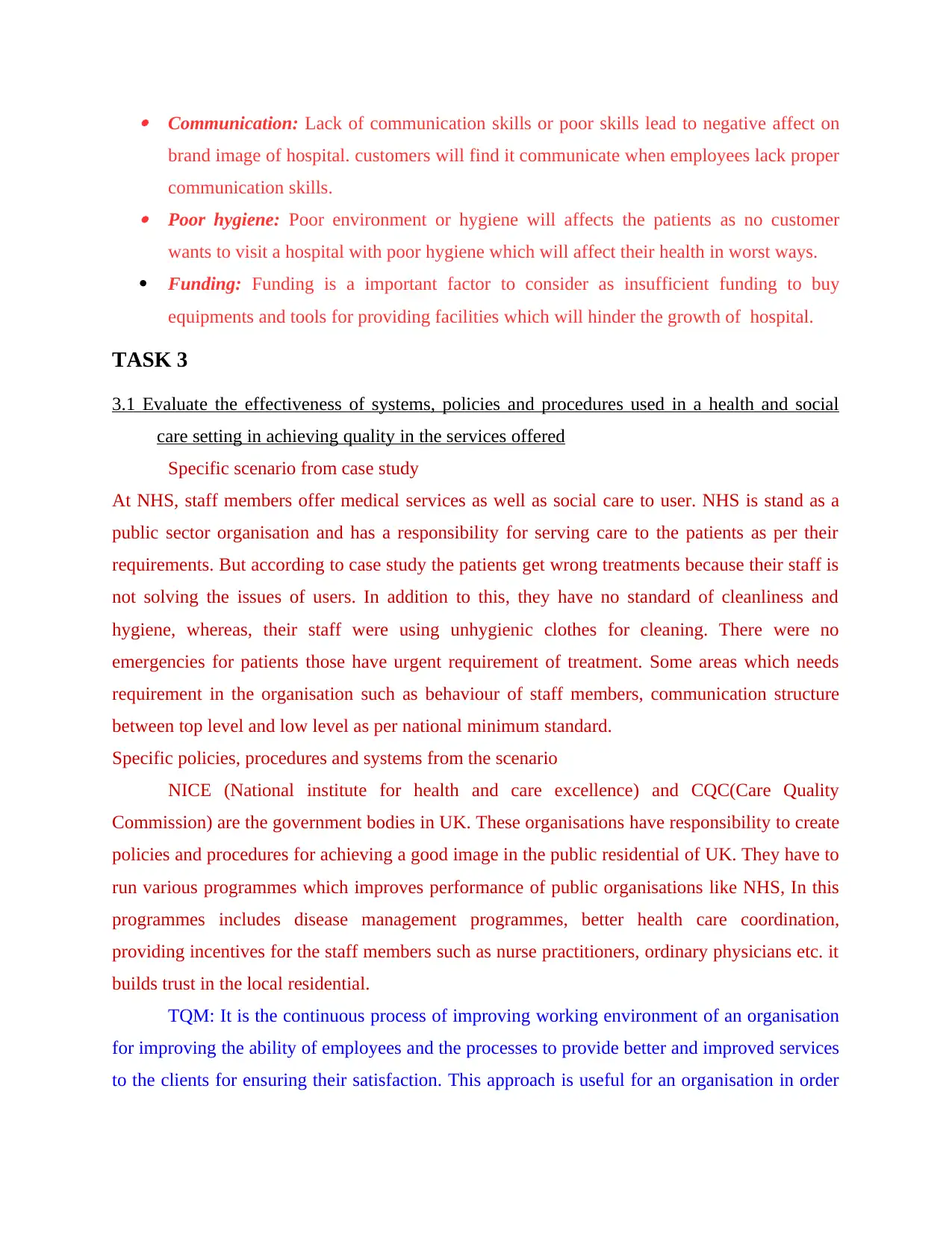
Communication: Lack of communication skills or poor skills lead to negative affect on
brand image of hospital. customers will find it communicate when employees lack proper
communication skills. Poor hygiene: Poor environment or hygiene will affects the patients as no customer
wants to visit a hospital with poor hygiene which will affect their health in worst ways.
Funding: Funding is a important factor to consider as insufficient funding to buy
equipments and tools for providing facilities which will hinder the growth of hospital.
TASK 3
3.1 Evaluate the effectiveness of systems, policies and procedures used in a health and social
care setting in achieving quality in the services offered
Specific scenario from case study
At NHS, staff members offer medical services as well as social care to user. NHS is stand as a
public sector organisation and has a responsibility for serving care to the patients as per their
requirements. But according to case study the patients get wrong treatments because their staff is
not solving the issues of users. In addition to this, they have no standard of cleanliness and
hygiene, whereas, their staff were using unhygienic clothes for cleaning. There were no
emergencies for patients those have urgent requirement of treatment. Some areas which needs
requirement in the organisation such as behaviour of staff members, communication structure
between top level and low level as per national minimum standard.
Specific policies, procedures and systems from the scenario
NICE (National institute for health and care excellence) and CQC(Care Quality
Commission) are the government bodies in UK. These organisations have responsibility to create
policies and procedures for achieving a good image in the public residential of UK. They have to
run various programmes which improves performance of public organisations like NHS, In this
programmes includes disease management programmes, better health care coordination,
providing incentives for the staff members such as nurse practitioners, ordinary physicians etc. it
builds trust in the local residential.
TQM: It is the continuous process of improving working environment of an organisation
for improving the ability of employees and the processes to provide better and improved services
to the clients for ensuring their satisfaction. This approach is useful for an organisation in order
brand image of hospital. customers will find it communicate when employees lack proper
communication skills. Poor hygiene: Poor environment or hygiene will affects the patients as no customer
wants to visit a hospital with poor hygiene which will affect their health in worst ways.
Funding: Funding is a important factor to consider as insufficient funding to buy
equipments and tools for providing facilities which will hinder the growth of hospital.
TASK 3
3.1 Evaluate the effectiveness of systems, policies and procedures used in a health and social
care setting in achieving quality in the services offered
Specific scenario from case study
At NHS, staff members offer medical services as well as social care to user. NHS is stand as a
public sector organisation and has a responsibility for serving care to the patients as per their
requirements. But according to case study the patients get wrong treatments because their staff is
not solving the issues of users. In addition to this, they have no standard of cleanliness and
hygiene, whereas, their staff were using unhygienic clothes for cleaning. There were no
emergencies for patients those have urgent requirement of treatment. Some areas which needs
requirement in the organisation such as behaviour of staff members, communication structure
between top level and low level as per national minimum standard.
Specific policies, procedures and systems from the scenario
NICE (National institute for health and care excellence) and CQC(Care Quality
Commission) are the government bodies in UK. These organisations have responsibility to create
policies and procedures for achieving a good image in the public residential of UK. They have to
run various programmes which improves performance of public organisations like NHS, In this
programmes includes disease management programmes, better health care coordination,
providing incentives for the staff members such as nurse practitioners, ordinary physicians etc. it
builds trust in the local residential.
TQM: It is the continuous process of improving working environment of an organisation
for improving the ability of employees and the processes to provide better and improved services
to the clients for ensuring their satisfaction. This approach is useful for an organisation in order
Paraphrase This Document
Need a fresh take? Get an instant paraphrase of this document with our AI Paraphraser
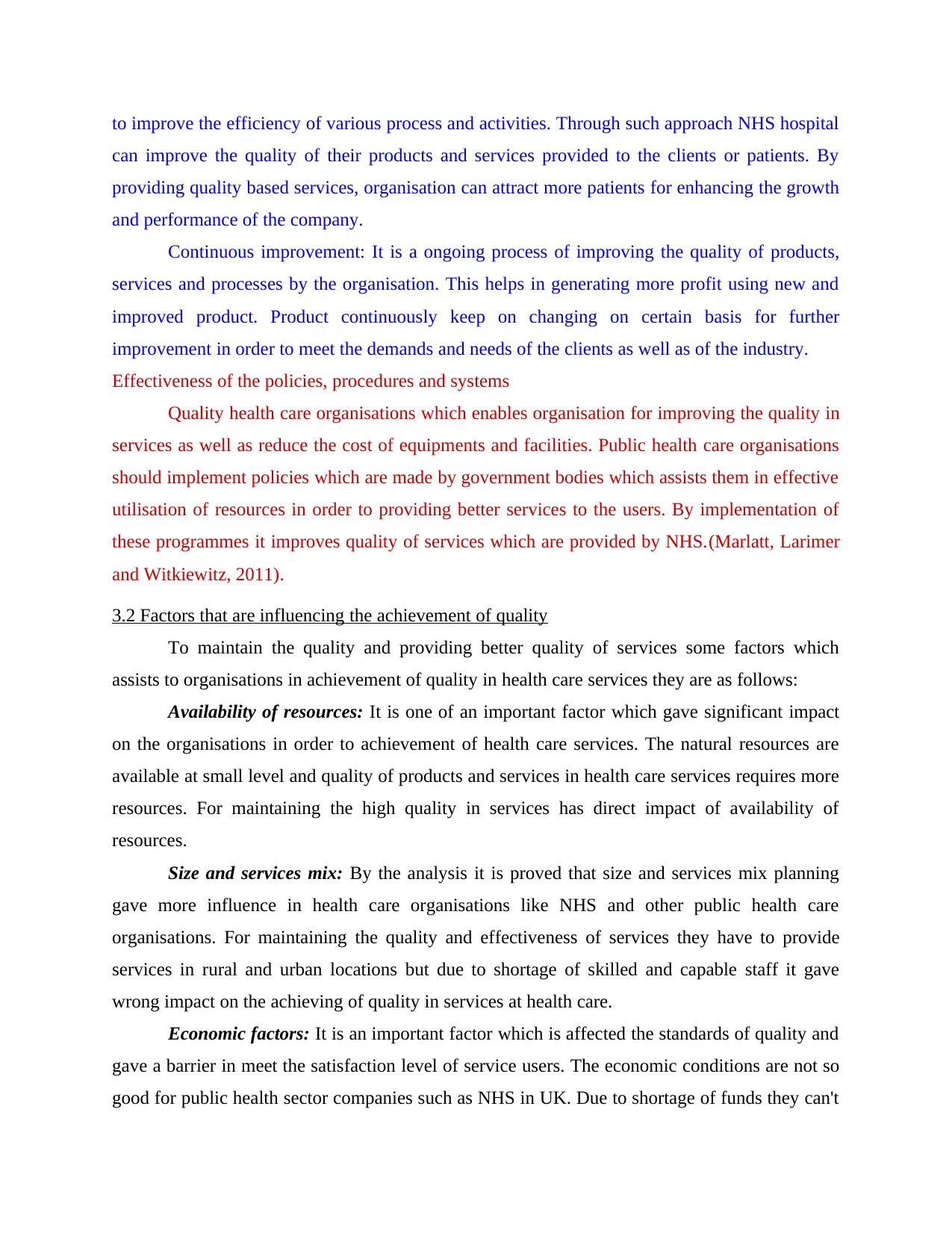
to improve the efficiency of various process and activities. Through such approach NHS hospital
can improve the quality of their products and services provided to the clients or patients. By
providing quality based services, organisation can attract more patients for enhancing the growth
and performance of the company.
Continuous improvement: It is a ongoing process of improving the quality of products,
services and processes by the organisation. This helps in generating more profit using new and
improved product. Product continuously keep on changing on certain basis for further
improvement in order to meet the demands and needs of the clients as well as of the industry.
Effectiveness of the policies, procedures and systems
Quality health care organisations which enables organisation for improving the quality in
services as well as reduce the cost of equipments and facilities. Public health care organisations
should implement policies which are made by government bodies which assists them in effective
utilisation of resources in order to providing better services to the users. By implementation of
these programmes it improves quality of services which are provided by NHS.(Marlatt, Larimer
and Witkiewitz, 2011).
3.2 Factors that are influencing the achievement of quality
To maintain the quality and providing better quality of services some factors which
assists to organisations in achievement of quality in health care services they are as follows:
Availability of resources: It is one of an important factor which gave significant impact
on the organisations in order to achievement of health care services. The natural resources are
available at small level and quality of products and services in health care services requires more
resources. For maintaining the high quality in services has direct impact of availability of
resources.
Size and services mix: By the analysis it is proved that size and services mix planning
gave more influence in health care organisations like NHS and other public health care
organisations. For maintaining the quality and effectiveness of services they have to provide
services in rural and urban locations but due to shortage of skilled and capable staff it gave
wrong impact on the achieving of quality in services at health care.
Economic factors: It is an important factor which is affected the standards of quality and
gave a barrier in meet the satisfaction level of service users. The economic conditions are not so
good for public health sector companies such as NHS in UK. Due to shortage of funds they can't
can improve the quality of their products and services provided to the clients or patients. By
providing quality based services, organisation can attract more patients for enhancing the growth
and performance of the company.
Continuous improvement: It is a ongoing process of improving the quality of products,
services and processes by the organisation. This helps in generating more profit using new and
improved product. Product continuously keep on changing on certain basis for further
improvement in order to meet the demands and needs of the clients as well as of the industry.
Effectiveness of the policies, procedures and systems
Quality health care organisations which enables organisation for improving the quality in
services as well as reduce the cost of equipments and facilities. Public health care organisations
should implement policies which are made by government bodies which assists them in effective
utilisation of resources in order to providing better services to the users. By implementation of
these programmes it improves quality of services which are provided by NHS.(Marlatt, Larimer
and Witkiewitz, 2011).
3.2 Factors that are influencing the achievement of quality
To maintain the quality and providing better quality of services some factors which
assists to organisations in achievement of quality in health care services they are as follows:
Availability of resources: It is one of an important factor which gave significant impact
on the organisations in order to achievement of health care services. The natural resources are
available at small level and quality of products and services in health care services requires more
resources. For maintaining the high quality in services has direct impact of availability of
resources.
Size and services mix: By the analysis it is proved that size and services mix planning
gave more influence in health care organisations like NHS and other public health care
organisations. For maintaining the quality and effectiveness of services they have to provide
services in rural and urban locations but due to shortage of skilled and capable staff it gave
wrong impact on the achieving of quality in services at health care.
Economic factors: It is an important factor which is affected the standards of quality and
gave a barrier in meet the satisfaction level of service users. The economic conditions are not so
good for public health sector companies such as NHS in UK. Due to shortage of funds they can't
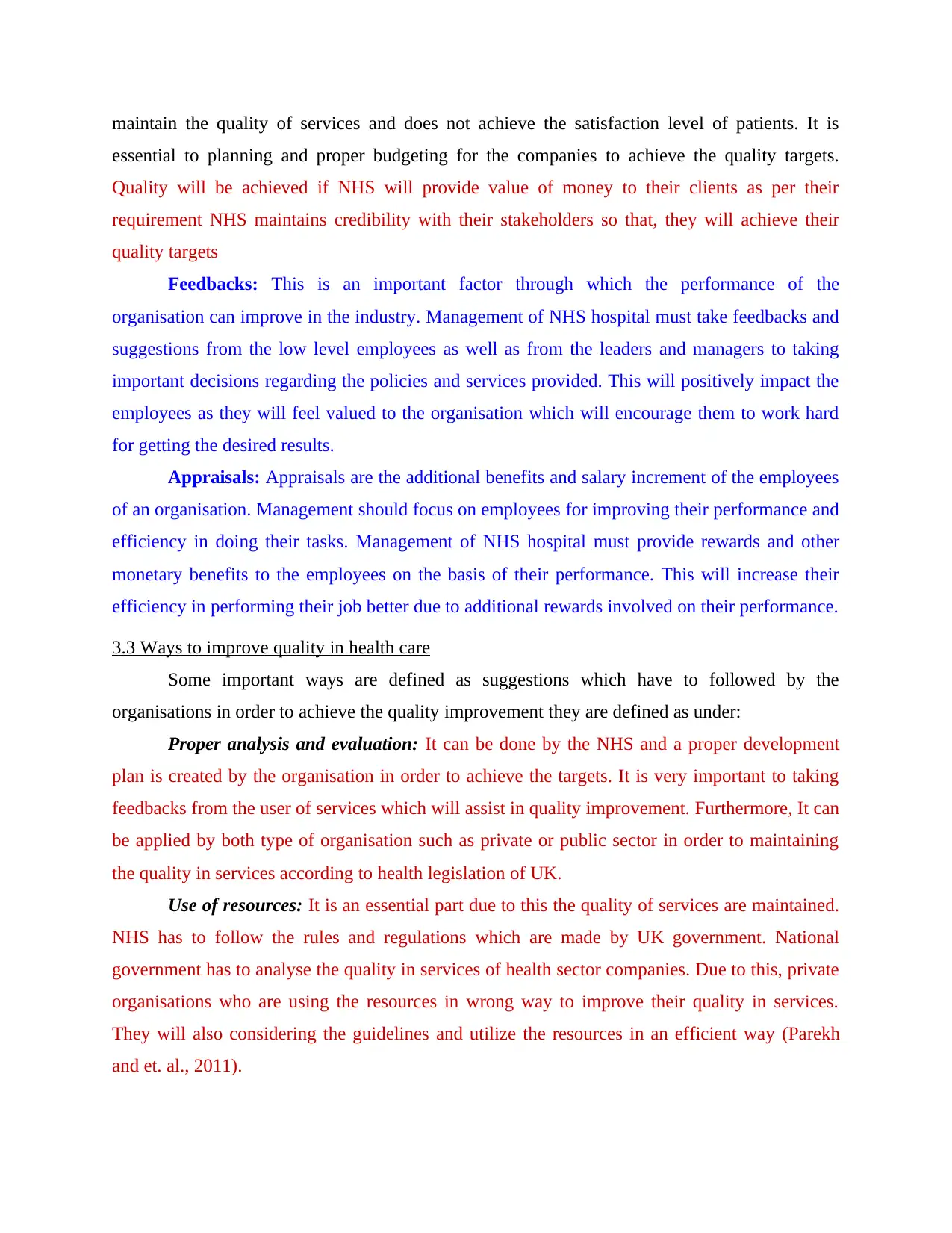
maintain the quality of services and does not achieve the satisfaction level of patients. It is
essential to planning and proper budgeting for the companies to achieve the quality targets.
Quality will be achieved if NHS will provide value of money to their clients as per their
requirement NHS maintains credibility with their stakeholders so that, they will achieve their
quality targets
Feedbacks: This is an important factor through which the performance of the
organisation can improve in the industry. Management of NHS hospital must take feedbacks and
suggestions from the low level employees as well as from the leaders and managers to taking
important decisions regarding the policies and services provided. This will positively impact the
employees as they will feel valued to the organisation which will encourage them to work hard
for getting the desired results.
Appraisals: Appraisals are the additional benefits and salary increment of the employees
of an organisation. Management should focus on employees for improving their performance and
efficiency in doing their tasks. Management of NHS hospital must provide rewards and other
monetary benefits to the employees on the basis of their performance. This will increase their
efficiency in performing their job better due to additional rewards involved on their performance.
3.3 Ways to improve quality in health care
Some important ways are defined as suggestions which have to followed by the
organisations in order to achieve the quality improvement they are defined as under:
Proper analysis and evaluation: It can be done by the NHS and a proper development
plan is created by the organisation in order to achieve the targets. It is very important to taking
feedbacks from the user of services which will assist in quality improvement. Furthermore, It can
be applied by both type of organisation such as private or public sector in order to maintaining
the quality in services according to health legislation of UK.
Use of resources: It is an essential part due to this the quality of services are maintained.
NHS has to follow the rules and regulations which are made by UK government. National
government has to analyse the quality in services of health sector companies. Due to this, private
organisations who are using the resources in wrong way to improve their quality in services.
They will also considering the guidelines and utilize the resources in an efficient way (Parekh
and et. al., 2011).
essential to planning and proper budgeting for the companies to achieve the quality targets.
Quality will be achieved if NHS will provide value of money to their clients as per their
requirement NHS maintains credibility with their stakeholders so that, they will achieve their
quality targets
Feedbacks: This is an important factor through which the performance of the
organisation can improve in the industry. Management of NHS hospital must take feedbacks and
suggestions from the low level employees as well as from the leaders and managers to taking
important decisions regarding the policies and services provided. This will positively impact the
employees as they will feel valued to the organisation which will encourage them to work hard
for getting the desired results.
Appraisals: Appraisals are the additional benefits and salary increment of the employees
of an organisation. Management should focus on employees for improving their performance and
efficiency in doing their tasks. Management of NHS hospital must provide rewards and other
monetary benefits to the employees on the basis of their performance. This will increase their
efficiency in performing their job better due to additional rewards involved on their performance.
3.3 Ways to improve quality in health care
Some important ways are defined as suggestions which have to followed by the
organisations in order to achieve the quality improvement they are defined as under:
Proper analysis and evaluation: It can be done by the NHS and a proper development
plan is created by the organisation in order to achieve the targets. It is very important to taking
feedbacks from the user of services which will assist in quality improvement. Furthermore, It can
be applied by both type of organisation such as private or public sector in order to maintaining
the quality in services according to health legislation of UK.
Use of resources: It is an essential part due to this the quality of services are maintained.
NHS has to follow the rules and regulations which are made by UK government. National
government has to analyse the quality in services of health sector companies. Due to this, private
organisations who are using the resources in wrong way to improve their quality in services.
They will also considering the guidelines and utilize the resources in an efficient way (Parekh
and et. al., 2011).
⊘ This is a preview!⊘
Do you want full access?
Subscribe today to unlock all pages.

Trusted by 1+ million students worldwide
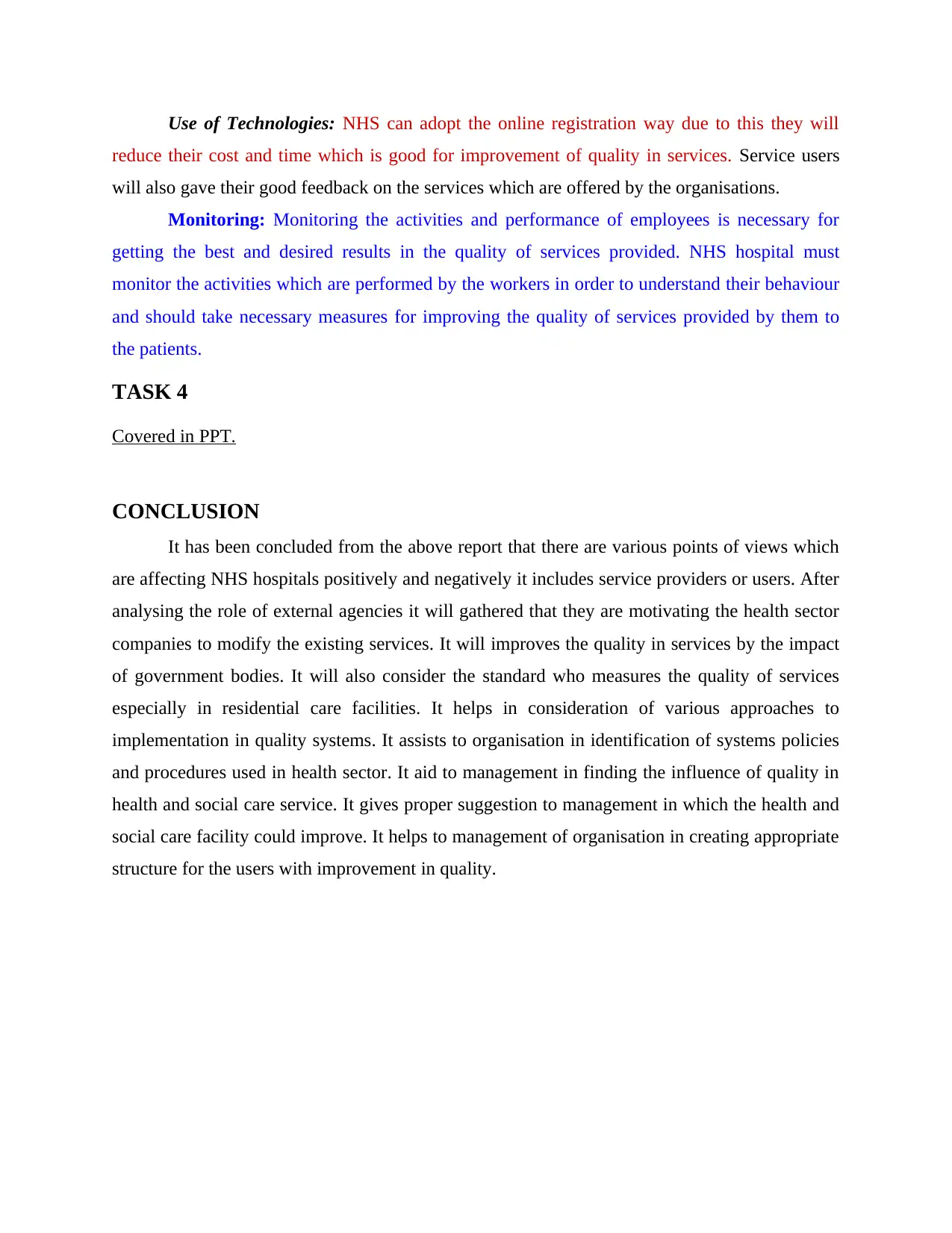
Use of Technologies: NHS can adopt the online registration way due to this they will
reduce their cost and time which is good for improvement of quality in services. Service users
will also gave their good feedback on the services which are offered by the organisations.
Monitoring: Monitoring the activities and performance of employees is necessary for
getting the best and desired results in the quality of services provided. NHS hospital must
monitor the activities which are performed by the workers in order to understand their behaviour
and should take necessary measures for improving the quality of services provided by them to
the patients.
TASK 4
Covered in PPT.
CONCLUSION
It has been concluded from the above report that there are various points of views which
are affecting NHS hospitals positively and negatively it includes service providers or users. After
analysing the role of external agencies it will gathered that they are motivating the health sector
companies to modify the existing services. It will improves the quality in services by the impact
of government bodies. It will also consider the standard who measures the quality of services
especially in residential care facilities. It helps in consideration of various approaches to
implementation in quality systems. It assists to organisation in identification of systems policies
and procedures used in health sector. It aid to management in finding the influence of quality in
health and social care service. It gives proper suggestion to management in which the health and
social care facility could improve. It helps to management of organisation in creating appropriate
structure for the users with improvement in quality.
reduce their cost and time which is good for improvement of quality in services. Service users
will also gave their good feedback on the services which are offered by the organisations.
Monitoring: Monitoring the activities and performance of employees is necessary for
getting the best and desired results in the quality of services provided. NHS hospital must
monitor the activities which are performed by the workers in order to understand their behaviour
and should take necessary measures for improving the quality of services provided by them to
the patients.
TASK 4
Covered in PPT.
CONCLUSION
It has been concluded from the above report that there are various points of views which
are affecting NHS hospitals positively and negatively it includes service providers or users. After
analysing the role of external agencies it will gathered that they are motivating the health sector
companies to modify the existing services. It will improves the quality in services by the impact
of government bodies. It will also consider the standard who measures the quality of services
especially in residential care facilities. It helps in consideration of various approaches to
implementation in quality systems. It assists to organisation in identification of systems policies
and procedures used in health sector. It aid to management in finding the influence of quality in
health and social care service. It gives proper suggestion to management in which the health and
social care facility could improve. It helps to management of organisation in creating appropriate
structure for the users with improvement in quality.
Paraphrase This Document
Need a fresh take? Get an instant paraphrase of this document with our AI Paraphraser
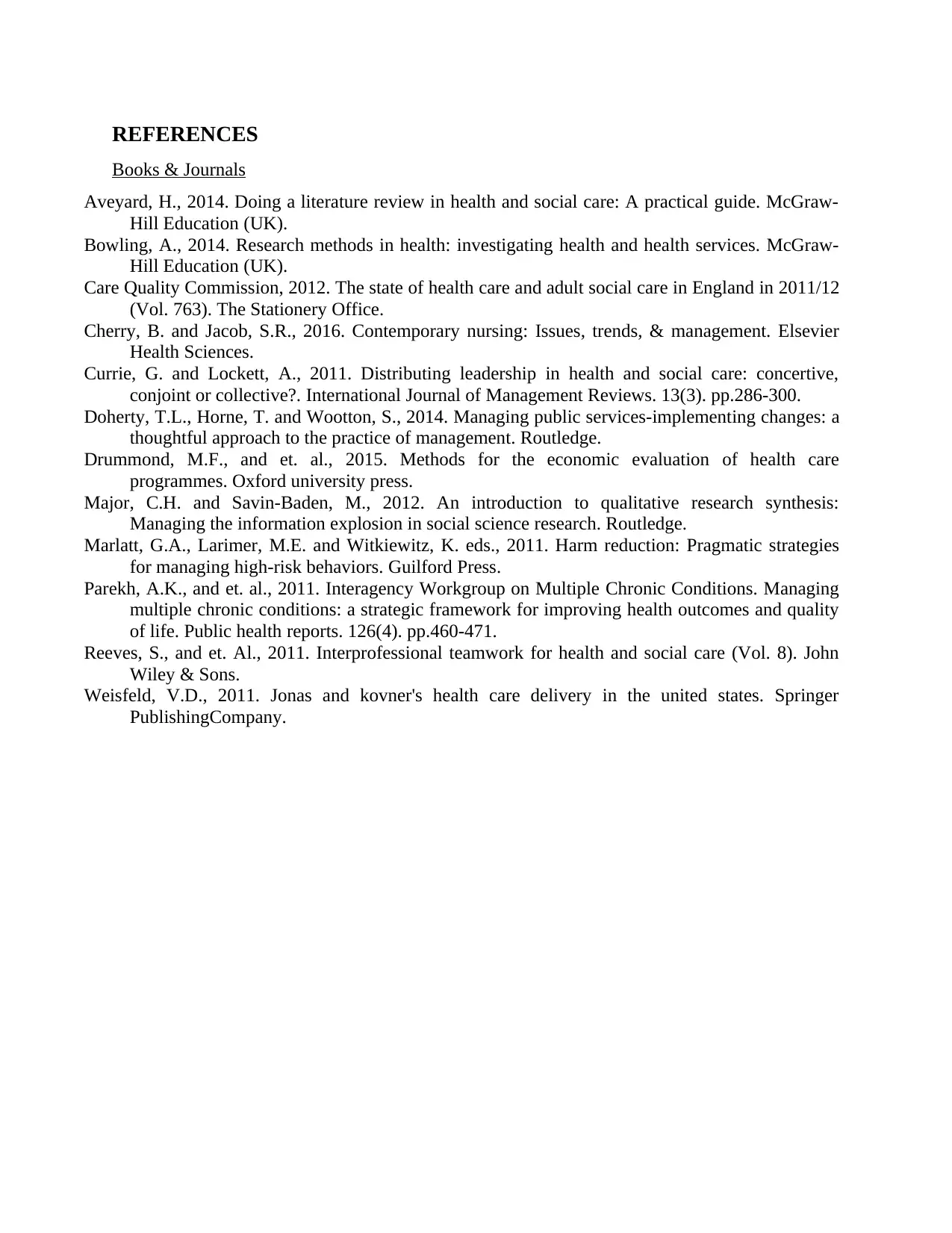
REFERENCES
Books & Journals
Aveyard, H., 2014. Doing a literature review in health and social care: A practical guide. McGraw-
Hill Education (UK).
Bowling, A., 2014. Research methods in health: investigating health and health services. McGraw-
Hill Education (UK).
Care Quality Commission, 2012. The state of health care and adult social care in England in 2011/12
(Vol. 763). The Stationery Office.
Cherry, B. and Jacob, S.R., 2016. Contemporary nursing: Issues, trends, & management. Elsevier
Health Sciences.
Currie, G. and Lockett, A., 2011. Distributing leadership in health and social care: concertive,
conjoint or collective?. International Journal of Management Reviews. 13(3). pp.286-300.
Doherty, T.L., Horne, T. and Wootton, S., 2014. Managing public services-implementing changes: a
thoughtful approach to the practice of management. Routledge.
Drummond, M.F., and et. al., 2015. Methods for the economic evaluation of health care
programmes. Oxford university press.
Major, C.H. and Savin-Baden, M., 2012. An introduction to qualitative research synthesis:
Managing the information explosion in social science research. Routledge.
Marlatt, G.A., Larimer, M.E. and Witkiewitz, K. eds., 2011. Harm reduction: Pragmatic strategies
for managing high-risk behaviors. Guilford Press.
Parekh, A.K., and et. al., 2011. Interagency Workgroup on Multiple Chronic Conditions. Managing
multiple chronic conditions: a strategic framework for improving health outcomes and quality
of life. Public health reports. 126(4). pp.460-471.
Reeves, S., and et. Al., 2011. Interprofessional teamwork for health and social care (Vol. 8). John
Wiley & Sons.
Weisfeld, V.D., 2011. Jonas and kovner's health care delivery in the united states. Springer
PublishingCompany.
Books & Journals
Aveyard, H., 2014. Doing a literature review in health and social care: A practical guide. McGraw-
Hill Education (UK).
Bowling, A., 2014. Research methods in health: investigating health and health services. McGraw-
Hill Education (UK).
Care Quality Commission, 2012. The state of health care and adult social care in England in 2011/12
(Vol. 763). The Stationery Office.
Cherry, B. and Jacob, S.R., 2016. Contemporary nursing: Issues, trends, & management. Elsevier
Health Sciences.
Currie, G. and Lockett, A., 2011. Distributing leadership in health and social care: concertive,
conjoint or collective?. International Journal of Management Reviews. 13(3). pp.286-300.
Doherty, T.L., Horne, T. and Wootton, S., 2014. Managing public services-implementing changes: a
thoughtful approach to the practice of management. Routledge.
Drummond, M.F., and et. al., 2015. Methods for the economic evaluation of health care
programmes. Oxford university press.
Major, C.H. and Savin-Baden, M., 2012. An introduction to qualitative research synthesis:
Managing the information explosion in social science research. Routledge.
Marlatt, G.A., Larimer, M.E. and Witkiewitz, K. eds., 2011. Harm reduction: Pragmatic strategies
for managing high-risk behaviors. Guilford Press.
Parekh, A.K., and et. al., 2011. Interagency Workgroup on Multiple Chronic Conditions. Managing
multiple chronic conditions: a strategic framework for improving health outcomes and quality
of life. Public health reports. 126(4). pp.460-471.
Reeves, S., and et. Al., 2011. Interprofessional teamwork for health and social care (Vol. 8). John
Wiley & Sons.
Weisfeld, V.D., 2011. Jonas and kovner's health care delivery in the united states. Springer
PublishingCompany.
1 out of 11
Related Documents
Your All-in-One AI-Powered Toolkit for Academic Success.
+13062052269
info@desklib.com
Available 24*7 on WhatsApp / Email
![[object Object]](/_next/static/media/star-bottom.7253800d.svg)
Unlock your academic potential
Copyright © 2020–2025 A2Z Services. All Rights Reserved. Developed and managed by ZUCOL.




